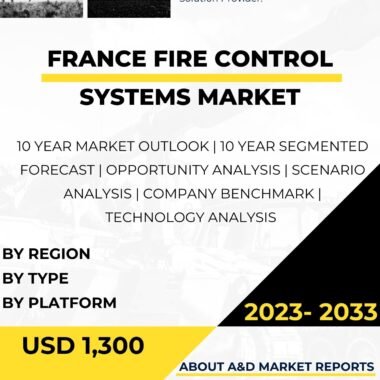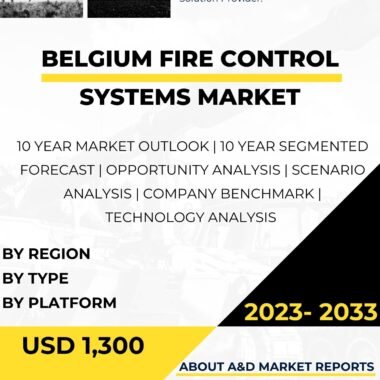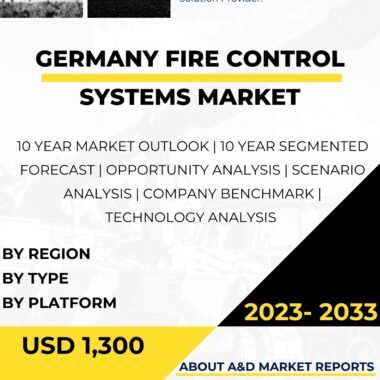Description
The South Korean fire control systems market plays a critical role in enhancing the country’s defense capabilities, ensuring the accuracy and effectiveness of its weapon systems, and maintaining a robust deterrence against potential adversaries. Fire control systems are essential components of military equipment, responsible for target acquisition, tracking, and accurate weapon guidance. South Korea’s investment in advanced fire control systems is driven by its regional security challenges, including the ever-present threat from North Korea, and the need to modernize its armed forces to keep pace with evolving technologies.
Over the years, South Korea has made significant strides in developing and procuring state-of-the-art fire control systems. These systems are utilized across various platforms, including tanks, armored vehicles, naval vessels, and aircraft. South Korea’s focus on indigenous development has been a cornerstone of its strategy to reduce reliance on foreign suppliers and foster growth in its defense industry.
One of the key areas where South Korea has excelled is in the development of fire control systems for its armored vehicles and tanks. The country’s main battle tank, the K2 Black Panther, is equipped with an advanced fire control system that ensures high accuracy and lethality. The fire control system incorporates cutting-edge technologies, such as thermal imaging, laser rangefinders, and ballistic computers, enabling the tank crew to engage targets with precision and speed even in challenging battlefield conditions.
Additionally, South Korea has actively pursued the development of artillery fire control systems. The K9 Thunder self-propelled howitzer, a flagship artillery system, is equipped with an advanced fire control system that allows for rapid and precise firing. The system incorporates various sensors and data processing capabilities to acquire and engage targets quickly, increasing the artillery’s effectiveness in both offensive and defensive operations.
Naval warfare is another area where South Korea’s fire control systems have seen significant advancements. The country’s naval vessels, including destroyers and frigates, are equipped with advanced radar and fire control systems that enhance their anti-air and anti-surface warfare capabilities. These systems enable seamless integration with various weapon systems, such as missiles and guns, ensuring effective target engagement and defense against air and surface threats.
In recent years, South Korea has also focused on developing fire control systems for its growing fleet of unmanned aerial vehicles (UAVs). These systems play a crucial role in UAVs’ intelligence, surveillance, and reconnaissance (ISR) missions, enabling real-time target acquisition and tracking. Advanced fire control systems integrated into UAVs enhance their capabilities in various operational scenarios, including monitoring borders, conducting reconnaissance missions, and supporting ground forces.
South Korea’s commitment to indigenous development and innovation in fire control systems has led to the integration of artificial intelligence (AI) and machine learning technologies. AI-based fire control systems offer improved situational awareness, autonomous target identification, and faster decision-making, thereby increasing the overall effectiveness of the armed forces.
To complement its indigenous efforts, South Korea also collaborates with international defense companies to access cutting-edge technologies and enhance its fire control capabilities further. These partnerships often involve technology transfer, joint research and development, and the integration of foreign systems into South Korea’s military equipment. Such collaborations contribute to the country’s continuous drive for technological advancement and the maintenance of its military edge.
Furthermore, South Korea’s fire control systems market extends beyond its domestic requirements. The country’s defense industry actively seeks opportunities to export its fire control systems to other countries, providing an additional source of revenue and expanding its influence in the global defense market. Successful exports of fire control systems have showcased the competitiveness and reliability of South Korean-made defense technologies.
To ensure the optimal utilization of fire control systems, South Korea emphasizes rigorous training and skill development for its military personnel. Training programs focus on familiarizing operators with the systems’ capabilities, enhancing their operational proficiency, and ensuring proper maintenance and upkeep.
In conclusion, the South Korean fire control systems market plays a vital role in strengthening the country’s defense capabilities. Indigenous development, international collaborations, and the integration of advanced technologies have enabled South Korea to create sophisticated fire control systems across various platforms, including tanks, artillery, naval vessels, and UAVs. The focus on accuracy, precision, and real-time target engagement ensures that South Korea’s armed forces maintain their readiness and effectiveness in countering potential threats. As the security landscape continues to evolve, South Korea’s dedication to advancing its fire control systems will remain essential in safeguarding its national security and maintaining regional stability.




